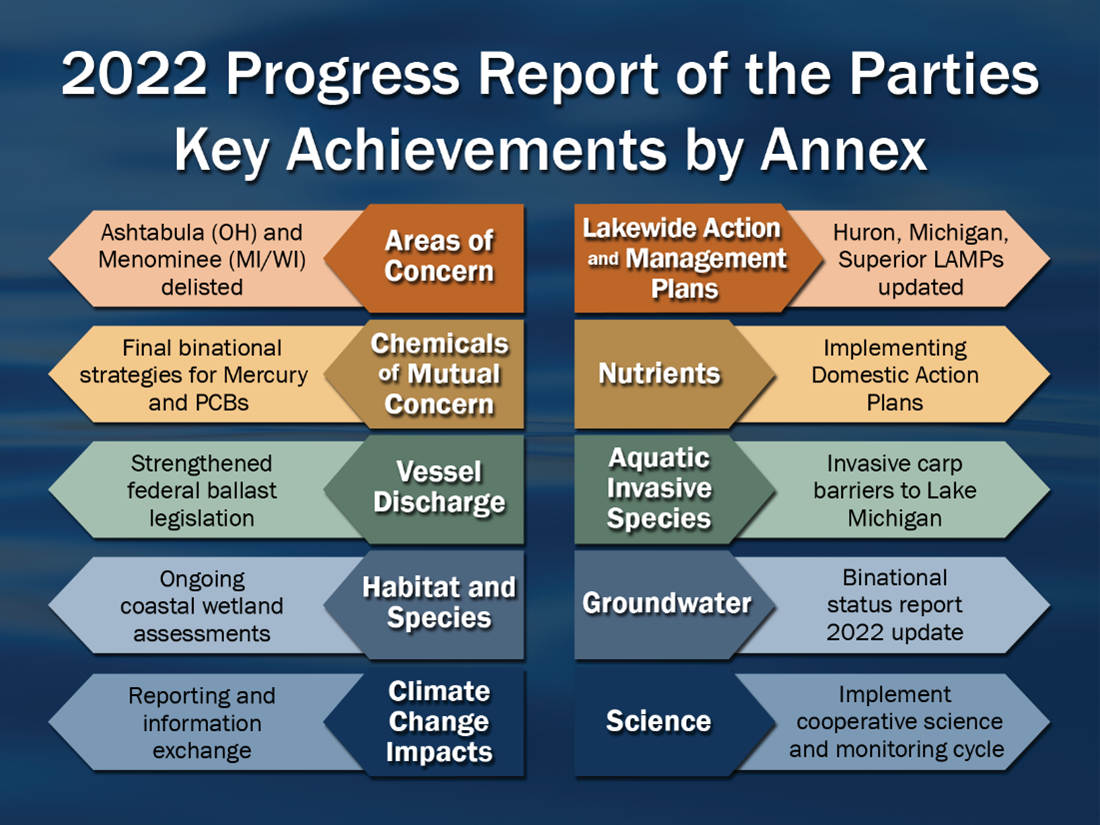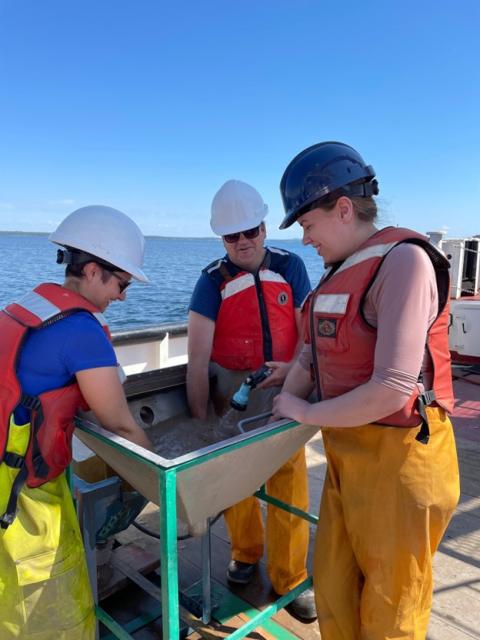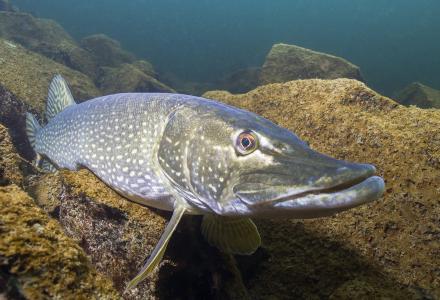
It takes many years to plan, coordinate, implement and verify the actions and programs that restore, protect and enhance the environmental health and water quality of the Great Lakes. This article highlights a few of the numerous achievements reported by the Canadian and United States governments from the past three years protecting the water quality in the Great Lakes.
Every three years, the federal governments of both countries summarize their programs, policies and actions completed domestically and binationally. The 2022 Progress Report of the Parties (PROP) has over 100 pages detailing government-led and funded activities under each of the 10 Annexes of the Great Lakes Water Quality Agreement achieved from 2020 to 2022.

A selection of key achievements Canadian and US governments highlight in the executive summary of their 2022 Progress Report of the Parties.
This article takes a lake-by-lake approach to highlight the latest achievements reported by the Canadian and US governments. The 2022 PROP provides much more detail about government-led activities under each of the Agreement Annexes. For example, the PROP describes not only the cleanup of two toxic hotspots but also the removal of 24 ecosystem impairments under Annex 1 on Areas of Concern.
As part of its responsibilities under the Great Lakes Water Quality Agreement, the International Joint Commission (IJC) evaluates the progress of these efforts to restore and protect the Great Lakes ecosystem. The IJC is now gathering public input on the PROP, so skim this article for a highlight reel or dive deep into the governments’ full report to inform your feedback. Visit this ijc.org page for details on the in-person and virtual ways you can provide your comments to the IJC.
(Looking for an assessment of the health of the lakes? The Canadian and US governments’ 2022 State of the Great Lakes report reports on the status and trend of the lakes using a variety of ecosystem indicators).
Decades of pollution and degradation across the Great Lakes requires significant investment and coordination to clean up, and governments continue to take actions that ensure that the lakes are healthy and suitable for drinking water, recreation, and fishing.
Lake Superior

Left: Kingsbury Bay pre‐restoration (August 2015). Right: Kingsbury Bay in August 2021 during sediment dredging. Credit: Minnesota Department of Natural Resources via the Great Lakes Restoration Initiative
South of the Morgan Park neighborhood in Duluth, Minnesota is the Spirit Lake area of the St. Louis River Area of Concern where legacy toxic chemicals impair the water, sediment and shoreline soil. In 2020, the US Environmental Protection Agency (USEPA), in partnership with US Steel Corporation, began operations to dredge, cap and monitor the sediment.
Just downriver, a three-year restoration project completed in 2021 transformed Kingsbury Bay and Grassy Point from logging waste dump to valuable coastal marsh habitat.
Both Canadian and US research vessels spent much of 2021 conducting sampling and monitoring activities on Lake Superior as part of the binational Cooperative Science and Monitoring Initiative (CSMI).
Lake Michigan
As of fall 2020, and after more than 30 years of effort, the Menominee River is no longer a toxic hotspot on the binational list of “Areas of Concern.” Checking the Menominee river off the list (“delisting”) was a US federal priority for action, achieved through the cooperative remediation and restoration activities completed by USEPA, the states of Michigan and Wisconsin, and in partnership with other federal agencies, industry, private partners and local citizens.
Another win for Lake Michigan water quality: completion of the 17-year effort to clean up a historic 6.5 million cubic yards of contaminated sediments in the Lower Fox River and Green Bay in 2020.
While the global pandemic interrupted government sampling and monitoring activities in 2020, the CSMI on Lake Michigan resumed in 2021 to ensure collection of all the necessary data to keep track of water quality conditions.
Lake Huron

This year (2022), Canadian and US scientists teamed up to cruise Lake Huron for its turn in the “field year” cycle for intensive water quality monitoring. While these are not vacation cruises, the experts enjoy getting their hands dirty sifting through sediment to examine bottom-dwelling critters, as pictured below, to help understand issues like chemical pollution and food web structure.
Following improvements to the local wastewater treatment plant and reduction of pollution from an upstream paper mill, the Canadian government deemed the Spanish Harbour Area of Concern as “In Recovery” in 1999. The “In Recovery” title recognizes that cleanup actions are done, but it will take a long time for the ecosystem to recover and fix the problems caused by pollution. Canadian agencies regularly monitor to assess the situation (including the data gathered through the aforementioned CSMI), and, in 2020, Environment and Climate Change Canada concluded that it’s no longer a problem to dredge sediment in the Harbour.
Lake Erie
In 2021, USEPA announced the successful delisting of the Ashtabula River Area of Concern. Thanks to coordinated cleanup efforts through both the US Superfund and Area of Concern programs, the Ashtabula River saw the removal of more than 620,000 cubic yards of contaminated sediment, containing 14,000 pounds of PCBs, and the creation of over 2,500 linear feet of fish habitat. This has been a 30-year effort to remove six beneficial use impairments, with the last two—fish tumors and other deformities, and restrictions on dredging activities—removed in 2020.
To tackle the pernicious problem of harmful algal blooms in the Lake Erie basin, Canada and the US are making headway toward their goal to reduce their annual contributions of nutrients by 40 percent of 2008 levels. Through their domestic action plans, Canada saw a 44,000 pounds (20 tonnes) reduction in its annual phosphorus inputs, and the US reduced their output by over 3 million pounds (1,361 tonnes). The ErieStat dashboard has new progress indicators that help track nutrient reduction progress. While the latest nutrient reductions stats are signs of success, governments acknowledge that significant additional work is needed to meet the 40 percent nutrient reduction target. Read the 2022 PROP chapter on activities under the Nutrients Annex of the Great Lakes Quality Agreement to learn more about Canada and the United States’ nutrient reduction programs.
Lake Ontario
On the westernmost side of Lake Ontario in Hamilton Harbor, Randle Reef is on its way to shaking off its superlative title as Canada’s largest area of contaminated sediments. Cleaning up Randle Reef is a three-stage process, and in 2021 project partners completed the second stage, dredging the polluted sediment located outside of the engineered containment facility constructed in stage 1.
New York State’s Lake Sturgeon Recovery Plan reached a milestone in 2021 when the New York Department of Environmental Conservation found eggs of the threated Lake Sturgeon fish in the Genesee River for the first time in 50 years. At the mouth of the river, cleanup efforts on the Rochester Embayment Area of Concern helped relax restrictions on consuming fish and wildlife.
Be sure to add your voice to the assessment of the progress being made toward a healthy Great Lakes ecosystem. Visit this ijc.org page for details on the in-person and virtual ways you can provide your comments to the IJC.




